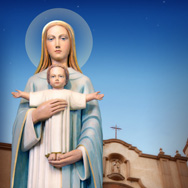The Conception ...
By Theo Tigno
In January 2011, I brought the "new" translation of the Roman Missal with me as a way to enter into prayer while I was in adoration. My holy hour is in the middle of the night so I needed to use something to help keep me active in adoring Our Lord in the Eucharist.
I started praying with the Gloria. I meditated on the time when the Gloria was proclaimed: the Nativity of Our Lord Jesus Christ. I thought about the build-up leading to the birth of Our Lord, with the angels anticipating that moment ...
... I imagined a solemn pause as Our Savior first breathed the air as a baby. In the midst of the chaos in the world, our Savior is welcomed to the world!
Unto us a Child is born and there was a gasp ... a pause ... a moment when a woman is taken aback when a man opens the box and reveals his intention to marry his beloved ... a gasp from a mother right before she cries after her child is delivered. It is a skip of a beat of the heart. Heaven and earth was taken aback by the birth of this humble Child. The King of Kings was born and all creation gasps in awe ...
 After this moment of reverent silence and awe, a TRIUMPHANT "Glory to God" is sung, revealing our pure joy and exaltation! The choirs of angels sing a Gloria to the triumphant King of Kings Who is at this time a humble baby. We now unite our voices with theirs and we are brought back to the joy of the Nativity! ...
After this moment of reverent silence and awe, a TRIUMPHANT "Glory to God" is sung, revealing our pure joy and exaltation! The choirs of angels sing a Gloria to the triumphant King of Kings Who is at this time a humble baby. We now unite our voices with theirs and we are brought back to the joy of the Nativity! ...
Inspired by this meditation, I sketched it out the melody in my notebook crudely, showing direction of melody with notes. I went home and plucked out the melody on my guitar to get the pitches ... and sat with it ... and it sat ...
I couldn't ignore the melody of the Gloria. In the restlessness, I wrote out the rest of the Gloria so that the prayer would be brought to completion. The more I wrote ... the more I entered into the text ... the more I was able to enter into the prayer. In the end came a triumphant "Amen!"
From the Gloria, all the other parts were developed ...
- The Alleluia borrows the melody from the Gloria. This melody would be fasted from in the Lenten season.
- The Great Amen uses the ending from the Gloria.
- The Sanctus builds each "Holy" until we proclaim "Holy Lord God of hosts" just as the beginning of the Gloria does.
- The Memorial Acclamation, Agnus Dei, and the Lenten Gospel Acclamation borrow phrases found in the Gloria.
... and thus, this Roman Missal setting was born as a fruit of prayer. I know that this setting has more to unpack and unfold, and as it matures, may God continue to be glorified.
Why is it called the Mass of the Immaculate Conception?
I was born on the Solemnity of the Immaculate Conception. I was inspired with this while in adoration at a parish named after Our Blessed Mother, Our Lady of Perpetual Help in Scottsdale, AZ. The meditation came brought me to the Nativity of Our Lord Jesus Christ, born of the Virgin Mary that night.
Why offer this setting?
I hope that it will help others enter into the prayer of the Mass. How can we not, for Jesus is truly present in the Eucharist! I hope this setting reveals what goes on internally in me as the text of the Mass is prayed. It is my joy to write this and I hope that others may share in this joy.
It is bittersweet for although I wrote this setting, I may not use this setting at the liturgies I serve at. I hope that others can have the opportunity to use these parts.
On obtaining approval
First of all, I am very glad that I went through the appropriate channels to receive approval for these settings. It is important that, as "one, holy, catholic and apostolic Church", we pray united in humility and obedience. This new translation is a gift to us; may we pray this gift with in union with the joy and hope of the Catholic Church!
With that in mind, if you have written a Mass setting, you should go through both the ICEL and USCCB to obtain approval. Simply email them your charts. I've experienced the ICEL usually getting back to you in the same day. They help ensure that the integrity of the Liturgy is upheld.
- © 2026 Treative Development. All rights reserved.
- Support Us
- Contact the Composer
- Site Map